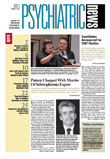APA has joined other physician groups in urging Congress to replace a 5.1 percent cut to Medicare's physician payments scheduled to take effect in January 2007 with an increase that reflects the actual costs of providing medical services.
“This is critical to ensure that Medicare can meet the medical needs of its beneficiaries,” said APA's Department of Government Relations in a statement sent to APA members.
APA also urged Congress to replace the formula used to determine physician fees—the sustainable growth rate (SGR)—with a formula more closely linked to the rate of medical inflation.
The physician groups are not alone in their crusade. Many senators and representatives have signed letters to congressional leaders asking that the cut be reversed. Although legislative momentum had not materialized by press time, many Republican members of Congress who are facing their tightest re-election races in years said that the issue that affects 700,000 physicians who treat seniors in the Medicare program is an important one to them.
AMA leaders regard the physician reimbursement issue as a bipartisan problem and noted that a bill to reverse the payment cut was no more likely to go forward if Democrats took control of the legislature.
“Offering a road map on the issue is legislation—HR 5866—that would erase the scheduled payment cut while arming Medicare beneficiaries with more information on the quality of physician care,” said Rep. Michael Burgess (R-Texas) in a House floor speech.
The physician fee cut stems from a 1997 measure that sets limits on annual Medicare fee increases for physician services and mandates cuts if the limits are exceeded. Medicare spending has risen dramatically in recent years because of the increasing volume and complexity of services. At the urging of physician groups and others, Congress froze 2006 fees at the previous year's levels to prevent a 4.4 percent cut required by the SGR, which was the fourth consecutive year Congress did so. Members of Congress and Bush administration officials agree that slashing physician fees by 40 percent over the next nine years is not feasible.
Although the federal government expects to pay physicians about $60 billion in 2007 under medicare, congressional staff and AMA officials could not agree on the total additional amount needed to reverse the cuts.
The AMA aims to convince Congress to delay the physician payment cut for up to two years while a reimbursement system that is fair to physicians and doesn't increase the burden on taxpayers can be developed. APA and other physician groups favor replacement of the SGR with fee updates based on the Medicare Economic Index (MEI), an approach offered under HR 5866.
The AMA is working with the Centers for Medicare and Medicaid Services to design 140 quality measures as the foundation of a new fee system. But much more work is needed, as only some medical specialty societies have developed potential benchmarks.
“It's fantasy to think that we're going to create a system to address quality issues in the next 30 days,” said AMA board member William Hazel Jr., M.D., in a teleconference last month with members of the media.
In the short term, the AMA warned that the scheduled cut in Medicare payments to physicians would force many to limit the number of older americans they see as patients. In fact, nearly half of the physicians responding to an AMA survey in March said they would stop taking on new Medicare patients or would reduce the number of Medicare patients they see if the 2007 cut is carried out.
The public is concerned as well: The AMA reported that 86 percent of the people responding to a survey it recently conducted were worried that physician payment cuts would hurt their ability to get care (see page 17).
“Those cuts could hinder the great strides we have made in health care and healthy living,” said Hazel.
CMS officials agree on the need for a revised system, but they said they want an approach that rewards physicians for quality care rather than paying by the quantity of office visits, tests, and procedures they provide.
The AMA launched a legislative blitz in September that encouraged physicians and the public to pressure Congress into rescinding the cut to physician fees.
“We're hoping the public will now pressure Congress to act,” Hazel said.
Further information on the Medicare payment to physicians is posted on APA's Web site at<www.capitolconnect.com/apa/alertdetail.aspx?AlertID=28>.▪
